Are you looking for the best audio interface under $300? Then, you’re in the right place.
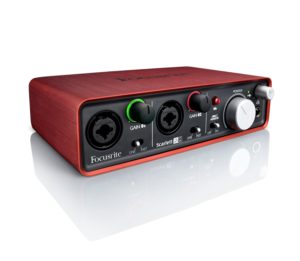
Computers have become a way of life for most people, and there’s a big reason for that: convenience. Especially in 2017 and beyond, there’s so much you can do on a computer – you don’t need anything else.
That concept applies in the world of audio, especially for those interested in the various modes of online communication such as podcasts, audiobooks, music recording, and videos. All you have to do is hook up to a computer for excellent audio quality, and the world is basically at your fingertips.
And even if you’re not into production, videos, or audio editing, having a good audio interface and microphone can make a world of difference for those who enjoy communicating via channels like skype or google hangouts.
That’s what makes the audio interface key. It’s the connector between your microphone, computer, and rest of the world — so having a good one is vital. As long as you’re not recording and producing the next great rock band of your era, you probably don’t need significant studio-quality equipment.
With that said, you can still get superior studio-quality sound from some relatively cheap options, so that’s where this buying guide comes into play.
We’re setting out to find the best audio interface for under 200 dollars. So join us, and we’ll let you know exactly what to purchase and why.
Top 5 Best Audio Interfaces Under $300:
| Image | Model | Price |
|---|---|---|
 | Focusrite Scarlett Solo (Top Pick) | Check Price |
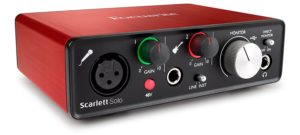 | Focusrite Scarlett 2i2 (Close Runner-Up) | Check Price |
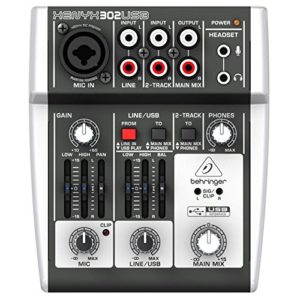 | Behringer Xenyx (Best on a Budget - Under $100) | Check Price |
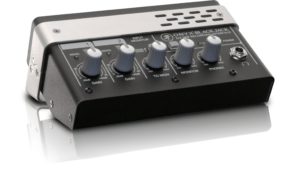 | Mackie Onyx Blackjack | Check Price |
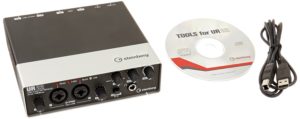 | Steinberg UR22 | Check Price |
Focusrite Scarlett Solo (Editor’s Choice)
The Focusrite Scarlett Solo is going to look as good as it sounds. It’s small and compact, perfect for the traveling musician or producer, and it comes in sharp scarlet color.
It’s only a 2 in / 2 out, so you won’t be able to use it to record a ton of sounds at once, but on a small-scale basis — you get a ton for the price. That’s not even mentioning the software and plugins that come with it. You get First & Ableton Live Lite recording software, Focusrite Control, and a Tone Bundle, among other things.
If you’re looking to improve your microphone sound, this is the perfect unit for you. Even with instruments, though, the Scarlett Solo can handle a lot, and it will provide crisp and studio-quality sound.
Pros
- Conversion and sample rates up to 192kHz / 24 bit
- Instrument input with strong capability
- Stereo line outputs for home speakers.
- Headphone output
- Includes multiple plugins/software
- Mac and PC compatible
Cons
- Headphone requires 1/4” jack/adapter likely needed.
- Short USB cable
- Only one mic input
Focusrite Scarlett 2i2 – Best USB Audio Interface for Beginners
The Scarlett is a very nice-looking interface that is easy to install, set up, and use right away. You don’t need to be a mixing or recording mastermind to use it, so it’s a good audio interface to get for beginners – especially if you don’t want to spend a ton of money.
This interface does an excellent job of transferring the audio quality you’re looking for.
The cool thing about purchasing the Scarlett is that you get access to its Plugin Suite, the Red 2 & Red 3 Plug-in Suite, The Softube Time and Tone Bundle, the Novation Bass Station, and you’ll get 1GB of Loopmasters samples. So you’ll have everything you’ll need to get a recording and produce.
It’s a quiet and simple yet powerful device that will provide you with the warm tones you’re looking for.
Pros
- Metal Unibody Case
- USB audio interface
- Combo Jack which allows for XLR and 1/4” inch connection
- Includes access to software
Cons
- May require USB hub to power
- May not be compatible will all software
- Connectivity issues seem common
- Not for high-quality, studio-grade mixing
Behringer Xenyx – Best Budget USB Audio Interface
For the price, you’re getting a ton of control out of the Behringer Xenyx. The XLR & ¼ inch combination input can be a bit tricky to figure out, but it is a pretty cool feature — though you’ll only be able to use one or the other.
It’s plug-and-play and has phantom power. It’s also powered by a USB that connects to your computer, so you’ll easily be able to control just about everything right on your laptop or desktop.
This unit doesn’t have a ton of power to it, but you’ll be able to control and EQ your sound, and it also has a 2-track channel, which is unique to this list.
This is a low-power, low-end device. You’ll be able to get solid quality out of it — especially with all the controls and inputs – but it doesn’t pack a ton of juice or punch.
Pros
- Small analog mixer with USB/Audio interface
- Phantom powered XENYX Mic Preamp
- Perfect price for what you’re getting
- Built-in EQ
- 5-Input Mixer
- XLR & ¼ inch combination input
- Dedicated 2-Track input.
- It comes with software needed to record and produce
Cons
- Only 1 Mic-in/1’4” input
- One power setting (15v).
- Has a hard time handling max input without hiss
Mackie Onyx Blackjack
Checking in at just under 100 dollars, you’re going to get a lot of bang for your buck with the Onyx Blackjack. It’s compact and small, so it’s not going to take up a ton of room, but it provides excellent audio quality and versatility.
The nice thing about it is that it can be plug-and-play both on Mac or PC because it doesn’t require drivers to work.
With two inputs, phantom power and the ability to control your headphones, this is an excellent interface for podcasters or anybody working with a limited amount of space. The USB connection to your computer also powers the unit, which is a nice perk because you won’t need another cable to run it.
This unit has AD/DA converters and DI’s, and analog hardware allows you to control the inputs easily. You can also use it in mono or stereo.
Pros
- Two mic preamps
- Tracktion 3™ Music Production Software included
- Cirrus Logic® AD/DA converters with 114dB dynamic range
- Mac or PC compatible
- Plug and play
Cons
- Playback can glitch
- Unpredictable compatibility with drivers depending on what you are using
- Only two inputs
Steinberg UR22 – Perfect USB Audio Interface for Mobile Musicians
The UR22 is an excellent audio interface.
It is a tool for people looking for something more than just a connection between their mic and computer. It gives the user a bit more control once the drivers are set up, and it’s a very high-quality machine. It doesn’t look like much, but it is a piece of professional equipment.
Though the preamps can be a bit sensitive depending on how much and what you’re pumping through, they provide solid gain, and the unit always seems to find a good signal and a clear, crisp sound — especially for vocals.
You can track just about any instrument on the UR22, and it does come with free software – which is a nice bonus.
Pros
- Two D-PRE microphone preamps / 2-in/2-out device.
- 24-bit/192 kHz converters
- Phantom Power
- Pad Switches
- Master volume knob
- Onboard dspMixFx technology
Cons
- Sensitive preamps
- Mac users must download the driver to use
- Not compatible with iPad or mobile
- Well, it’s not the best audio interface, even for Cubase! So, we recommend buying other options from this list 🙂
How to Choose the Best Audio Interface Under $300
What is a Good Audio Interface?
These are simple questions, but they can make a world of difference for the average audio interface buyer. Not every interface is made the same, and not every consumer has the same needs. So use these basic questions to point you in the right direction.
How Many Inputs?
The idea of the audio input is simple. How many inputs will you send into your audio interface, and how many can it handle?
The answer to this question varies depending on the model and price. For example, smaller interfaces may have one or two inputs, designed explicitly for microphones.
Those smaller, simpler audio interfaces are suitable for people who want to hook up a microphone to speak or sing. It’s simple, but the need is simple — you want your voice to go from the mic and into the computer.
Other interfaces will have more channels, which means you’ll be able to accommodate more inputs. For example, there will be a line-in or two for a guitar or bass connecting in via a quarter-inch cable, and maybe more than two XLR mic inputs will give you more options as the user.
Step one for determining what audio interface to get is knowing why you need an audio interface in the first place. For example, a podcaster will need a different interface than a garage band.
Phantom Power?
If you need or desire to use a condenser microphone through your interface, the ability to turn on phantom power (+48V) is crucial. The mic won’t work without it. It is a feature that not every interface may have, but it’s important to know about.
To turn on and charge the electrically charged plate that allows a condenser microphone, condense your interface will need to have phantom power, which sends the correct power (+48V) to that plate and allows the mic to work.
Not having phantom power isn’t a big deal if you plan on using dynamic microphones, but if you need a condenser mic for any reason, having that (+48V) power is vital. So make sure your interface has it.
Computer Compatibility
Perhaps this is the most straightforward point of them all, but it’s essential. The audio interface’s whole point is to connect sound to your computer so that your computer can recognize it.
But how does it connect, and is that compatible with your computer? USB connections are pretty standard with audio interfaces, but there are other, faster options.
Thunderbolt and Firewire bring high speed, and quality to the data transfer, but perhaps not every computer or interface is equipped to connect with those.
Also, consider this: Does your interface work with Mac and PC, or just one or the other? It would be silly to buy an interface that only works on a PC if you have a Mac and vice-versa.
Mixing Capability
If you’re a simple one-mic podcaster, maybe you don’t care about the ability to mix the channels to get the proper tones and levels that you’re looking for.
If you’re in a band or are putting together music, though, this can be a considerable part of the recording process.
Some audio interfaces allow you to mix on the hardware, so you have much more control of the sound once it gets to the recording program. Others are too small and simple, so again, you have to know what you want and what you’re looking for.
The more control you want over your sound, the bigger and more elaborate the interface will be. A mixer interface is undoubtedly an option, but it’s not for everyone.
The Best Audio Interface Under $300: The Takeaway
Just like with anything, different audio interfaces work best for different needs.
Some are a bit more heavy-duty and require more heavy lifting. Others are simple but give the user the ability to record themselves in various ways. You won’t get much control from the hardware itself at this range, but that’s what the drivers and software are for.
As far as finding the best audio interface for under 200 dollars, our money would go to the Mackie Onyx Blackjack. Of course, it’s just under 100 dollars, so it’s well below budget, but it provides everything you need in a solid audio interface.
It’s compact, works with Mac or PC, is connected and powered by the USB, and it’s plug-and-play ready. For the price, that’s just about all you can ask for out of an audio interface, and there’s software included, so if you pick one of these up, you’ll be well on your way towards recording and producing in no time.
It truly is the best audio interface for under $300.